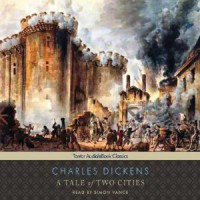Rediscovering a Classic

I read A Tale of Two Cities in high school and remembered only a few major characters, the setting, and of course, the knitting. Rereading it after decades of immersion in more recent fiction, I was intrigued by things I never questioned or noticed as a high school junior.
The omniscient narrator sometimes has a cinematic perspective. The opening chapters are remarkably like the opening scenes of a movie, especially where the poor people of Paris drink the spilled red wine.
The awareness of privacy and interiority was to some extent still new. Dickens digresses in a fascinating observation of the individual minds and lives within each home, behind each window, each unknowable to the others. In the Pulitzer prize winning The Transformation of Virginia, 1740 -1790, historian Rhys Isaac connected the rise of literacy and solitary reading with this new sense of privacy, a new phenomenon in a largely public society where most people (other than the wealthy) shared sleeping spaces, even in taverns when traveling, and the wealthy were surrounded by servants. The book is set in the late 18th century when the sense of individual self and individual rights arose, and this of course, is part of the plot. So was that rumination on all those unique, unknowable souls really a digression? Yes and no. With private reflection and self-awareness come questions such as Charles Darnay and Sydney Carton ask themselves about their lives. Questions revolutionaries may also have asked themselves, before they lost their self-awareness to the Terror.
Dickens’ linguistic virtuosity is enjoyable in the same way as hearing a great singer hit a note and sustain it or seeing a dancer spin an impossible series of turns. No one told him not to use –ly adverbs. I found three in one sentence, but that line worked. Semicolons were more like pauses for air than the kind of punctuation we now use. His shift from third person omniscient point of view, past tense, into first person plural, present tense, for one suspenseful scene was unexpected yet effective, moving the reader’s consciousness directly into the shared tension and hope of a group of desperate travelers. He wrote at a time when authors were less constrained by an expected word count than they are now, and he clearly luxuriated in language and in scenes that fully develop a setting, character, or relationship. The plot would move along without his humorous and detailed portrait of Tellson’s Bank, but the pleasure in reading the book would be diminished. The plot would move without the full length of the scenes revealing the lives of the French poor and aristocracy who oppress them, but the emotional impact would be less.
Making no attempt to be impartial, Dickens the social reformer is fully present in the narrative.
Most characters are three-dimensional and complex, but the French aristocrats have few traits, serving as representatives of their caste. Of the major characters, Lucie is the most limited, seen through the eyes of men who idolize her—other characters and the author. (I confess I tired of her expressive forehead.) She struck me as an idealized Domestic Female, set in contrast to Madame Defarge and the Vengeance.
Sydney Carton is the most layered and interesting character. He's witty as he spars with the lawyer he works with, Mr. Stryver, but melodramatic with Lucie, and both aspects of his personality are believable. I also liked Miss Pross, though I’m undecided how I feel about her scene with Madame Defarge. It’s satisfying, but I’m not sure it’s plausible. It’s one part of the story that I completely forgot in the decades since I last read it.
If you also read this in high school and don’t remember much except the first and last lines and three or four characters, you may be impressed with it a second time around.
 3
3


